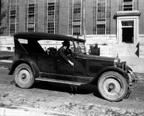The Roaring Twenties: Overview
The United States emerged from the Great War as a rich and powerful nation. American life changed dramatically in the 1920s, which saw the first trans-Atlantic phone call, the first movie with sound, the first enclosed car at popular prices, and the discovery of penicillin.

And suddenly everyone seemed to have a radio. Radio had been a topic of research interest at NIST since its early years, when both the Army and Navy set up separate research facilities at its site to study wireless telegraphy. By the late 1920s there were hundreds of broadcasting stations and nearly 10 million privately owned radio sets in the United States, including quite a few that were handmade using instructions published by NIST. The Institute built the first alternating-current (ac) radio set in 1922, years before commercial firms offered ac-powered radios for the home (earlier models were battery powered). The Institute also helped train radio technicians, published early reference works, and coordinated the writing of an academic textbook that was admired by Thomas Edison as "the greatest book on this subject that I have ever read."
Also booming in the 1920s were the building and construction and automobile industries, both of which received support from the nation's principal physical science research laboratory. NIST recommended revisions aimed at achieving greater uniformity in local building and plumbing codes and zoning regulations and published a popular handbook for prospective home buyers. NIST staff, in partnership with Underwriters Laboratories and the National Fire Protection Association, began developing methods to test the fire endurance of building structures; this work led to test procedures that became ubiquitous throughout the world.
Automobile research focused on two issues that would come to dominate the history of this technology-fuel economy and safety. Amid warnings that the nation's known petroleum reserves would be depleted in as little as 10 years, the Institute helped conserve gasoline by identifying the characteristics of engines, fuels, and oils that enhanced operating efficiency. To help establish safe driving speeds, it also investigated brakes, the braking ability of cars, and the reaction time of drivers in applying brakes.
Meanwhile, NIST became internationally known for its technical prowess. Radium, a radioactive element used in medical treatments, became so expensive that its discoverer, Marie Curie, had a difficult time obtaining enough for her own studies. American women raised money to buy some for her and, in 1921, Madame Curie visited the United States to receive a gram of radium from President Warren Harding. It came with a certificate from the Institute attesting to the purity and radioactivity of the sample.
While helping to enhance the quality of commercial products, the Institute also helped create new industries. After German sources of cane and beet sugar (sucrose) were cut off, for example, NIST scientists recreated the manufacturing processes to prepare small samples of corn sugar (dextrose) and other rare sugars for standardization and testing purposes. They also looked for ways to reduce costs, eventually developing a process for large-scale manufacturing of almost chemically pure, low-cost dextrose, which then became an industry unto itself. A spinoff of sugar research was the discovery of practical uses for process wastes. NIST developed products such as wall and insulating boards made from cornstalks, an early example of recycling.
Another way of making the most of American products was standards. High quality made a difference, too. In the 1920s, NIST standards became official federal standards, unifying the specifications of some 40 government purchasing agencies and achieving greater economies in supplies. The Institute quickly prepared specifications for items such as fire hoses, pneumatic tires, and shoe sole leather and recommended simplified practices, such as reducing the number of milk bottle designs from 49 to nine. American industry saved tens of millions of dollars through simplification. Standards also reduced the price of incandescent lamps from $1.30 to 16 cents. Then came the stock market crash in 1929 and the Great Depression, ending the crusade for a time.
| Notice of Online Archive: This page is no longer being updated and remains online for informational and historical purposes only. The information is accurate as of 2001. For questions about page contents, please inquiries [at] nist.gov (contact us). |

